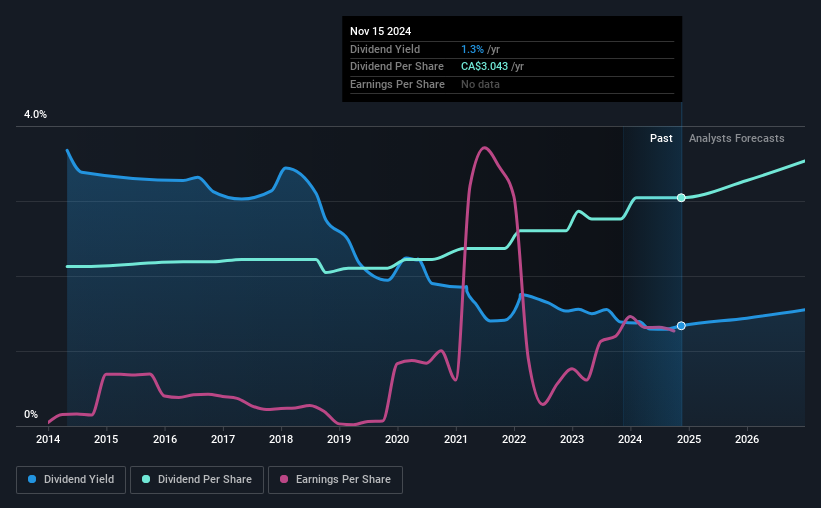- Canada
- /
- Professional Services
- /
- TSX:TRI
Here's What We Like About Thomson Reuters' (TSE:TRI) Upcoming Dividend

Thomson Reuters Corporation (TSE:TRI) is about to trade ex-dividend in the next four days. The ex-dividend date occurs one day before the record date which is the day on which shareholders need to be on the company's books in order to receive a dividend. The ex-dividend date is important because any transaction on a stock needs to have been settled before the record date in order to be eligible for a dividend. Therefore, if you purchase Thomson Reuters' shares on or after the 21st of November, you won't be eligible to receive the dividend, when it is paid on the 10th of December.
The company's upcoming dividend is US$0.54 a share, following on from the last 12 months, when the company distributed a total of US$2.16 per share to shareholders. Based on the last year's worth of payments, Thomson Reuters stock has a trailing yield of around 1.3% on the current share price of CA$227.74. Dividends are a major contributor to investment returns for long term holders, but only if the dividend continues to be paid. So we need to check whether the dividend payments are covered, and if earnings are growing.
Check out our latest analysis for Thomson Reuters
Dividends are typically paid out of company income, so if a company pays out more than it earned, its dividend is usually at a higher risk of being cut. That's why it's good to see Thomson Reuters paying out a modest 43% of its earnings. Yet cash flow is typically more important than profit for assessing dividend sustainability, so we should always check if the company generated enough cash to afford its dividend. Fortunately, it paid out only 46% of its free cash flow in the past year.
It's encouraging to see that the dividend is covered by both profit and cash flow. This generally suggests the dividend is sustainable, as long as earnings don't drop precipitously.
Click here to see the company's payout ratio, plus analyst estimates of its future dividends.

Have Earnings And Dividends Been Growing?
Stocks in companies that generate sustainable earnings growth often make the best dividend prospects, as it is easier to lift the dividend when earnings are rising. If business enters a downturn and the dividend is cut, the company could see its value fall precipitously. It's encouraging to see Thomson Reuters has grown its earnings rapidly, up 114% a year for the past five years. Earnings per share have been growing very quickly, and the company is paying out a relatively low percentage of its profit and cash flow. This is a very favourable combination that can often lead to the dividend multiplying over the long term, if earnings grow and the company pays out a higher percentage of its earnings.
Another key way to measure a company's dividend prospects is by measuring its historical rate of dividend growth. Since the start of our data, 10 years ago, Thomson Reuters has lifted its dividend by approximately 3.7% a year on average. Earnings per share have been growing much quicker than dividends, potentially because Thomson Reuters is keeping back more of its profits to grow the business.
To Sum It Up
From a dividend perspective, should investors buy or avoid Thomson Reuters? It's great that Thomson Reuters is growing earnings per share while simultaneously paying out a low percentage of both its earnings and cash flow. It's disappointing to see the dividend has been cut at least once in the past, but as things stand now, the low payout ratio suggests a conservative approach to dividends, which we like. There's a lot to like about Thomson Reuters, and we would prioritise taking a closer look at it.
On that note, you'll want to research what risks Thomson Reuters is facing. Every company has risks, and we've spotted 2 warning signs for Thomson Reuters (of which 1 is potentially serious!) you should know about.
A common investing mistake is buying the first interesting stock you see. Here you can find a full list of high-yield dividend stocks.
Valuation is complex, but we're here to simplify it.
Discover if Thomson Reuters might be undervalued or overvalued with our detailed analysis, featuring fair value estimates, potential risks, dividends, insider trades, and its financial condition.
Access Free AnalysisHave feedback on this article? Concerned about the content? Get in touch with us directly. Alternatively, email editorial-team (at) simplywallst.com.
This article by Simply Wall St is general in nature. We provide commentary based on historical data and analyst forecasts only using an unbiased methodology and our articles are not intended to be financial advice. It does not constitute a recommendation to buy or sell any stock, and does not take account of your objectives, or your financial situation. We aim to bring you long-term focused analysis driven by fundamental data. Note that our analysis may not factor in the latest price-sensitive company announcements or qualitative material. Simply Wall St has no position in any stocks mentioned.
About TSX:TRI
Thomson Reuters
Engages in the provision of business information services in the Americas, Europe, the Middle East, Africa, and the Asia Pacific.
Excellent balance sheet second-rate dividend payer.


